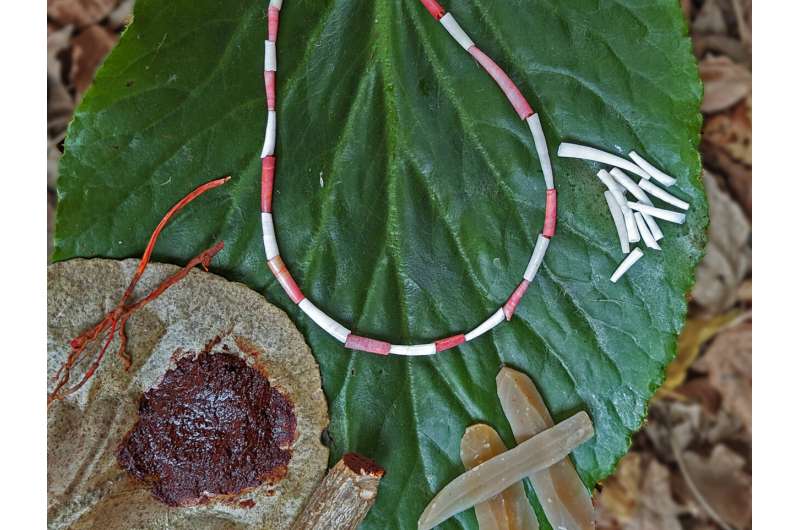October 26, 2023 report
This article has been reviewed according to Science X's editorial process and policies. Editors have highlighted the following attributes while ensuring the content's credibility:
fact-checked
peer-reviewed publication
trusted source
proofread
Beads found in Israel are the oldest known example of the use of organic red pigments

A team of archaeologists from The Hebrew University of Jerusalem's Institute of Archaeology, Sorbonne Universite and Conservatoire national des arts et métiers has found the oldest-known example of the use of organic red pigments to color an object—in this case, beads. In their study, reported on the open-access site PLOS ONE, the group used a variety of techniques to identify the source of red coloring on shell beads found in an Israeli cave decades ago.
The research effort began when one of its members noticed that an array of shell beads in a museum in Israel appeared to have an unusual red tint. A team was assembled to uncover the source of the material used to color the beads.
Prior research has shown that humans have used rocks and minerals to color objects red going back at least 500,000 years. But use of plant-based materials to redden objects came much later. Until this latest find, the earliest known example was from 6,000 years ago.
The team first ruled out an ochre source for the coloring and found that it contained a lot of carbon, a sign that it was likely from an organic source. Raman spectroscopy revealed signatures common to all the beads, which came from the same source—they also matched closely with compounds found in roots of plants of the Rubiaceae (madder) family.
The researchers noted that prior research has shown that madder plants were growing in the area near the end of the Pleistocene in the same region where the beads were found during the time of the Natufian culture. They also dated the beads to approximately 15,000 years ago, making them the oldest-known example of organic red pigment use.
The Natufian culture was active in the area from 11,650 to 15,000 years ago. During their time, they transitioned from a hunter-gatherer lifestyle to one that was primarily agricultural. Testing of the beads showed that some had come from the Mediterranean Sea and some from the Red Sea—they were found in the Kebara Cave. The research team suspects the people coloring the beads had crushed the roots of a local madder plant and then boiled the results—after fermenting, the liquid could have been used to dye the beads.
More information: Laurent Davin et al, Plant-based red colouration of shell beads 15,000 years ago in Kebara Cave, Mount Carmel (Israel), PLOS ONE (2023). DOI: 10.1371/journal.pone.0292264
Journal information: PLoS ONE
© 2023 Science X Network



















